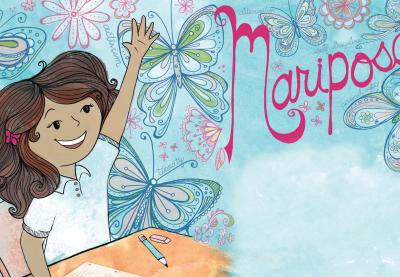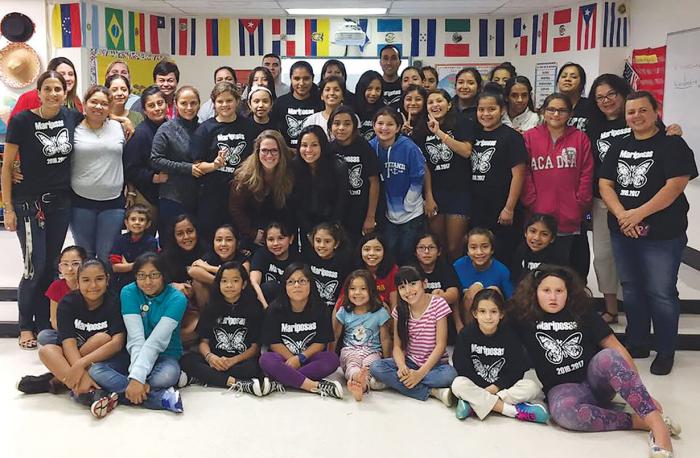In 2013, the first dual-language elementary school in Chapel Hill, North Carolina, opened its doors: Frank Porter Graham Bilingüe Elementary School. Principal Emily Bivins was thrilled to be offering services to approximately 450 K-5 students, almost half of whom were Latino.
But partway through the first school year, Bivins and her staff noticed something: The Latina students rarely raised their hands, even those who were at the top of their class. When school counselor Barbie Garayúa-Tudryn asked the students directly why they weren’t volunteering, one girl replied, “Think about the white kids. They know all the answers. They’re always right. I’m not always right. Think about what their parents do; they’re doctors and lawyers. Our parents clean their houses.”
The feelings of inferiority this student described were all too familiar to Garayúa-Tudryn. She came to the United States from Puerto Rico as a teenager and remembers immediately noticing a vastly different racial context. “People no longer viewed me as an equal,” she recalls.
Garayúa-Tudryn wanted the Latina girls attending Frank Porter Graham to have what she hadn’t—a resource that would boost their voices and help them feel confident in their identities despite navigating unfamiliar waters. With Bivins’ support, she decided to launch an empowerment group for Latina students called Mariposas (butterflies), a metaphor symbolizing transformation and migration.
The Mariposas curriculum focuses on six themes: determination, self-discipline, curiosity, activism, tenacity and personal safety. While the group’s bottom line is to improve school and community engagement, Garayúa-Tudryn and other group leaders work toward academic and personal success by discussing the realities of the Latino diaspora in the United States, collaborating with families and promoting civic ownership and socio-emotional health.
It’s necessary work, and not just because school participation is low. According to national data, one-third of Latino students do not expect to achieve their educational goals, and 14 percent drop out of school. Hispanic girls have higher than average rates of mental health issues and a higher rate of suicidal thoughts and behaviors than either non-Hispanic white female students or Hispanic male students. With the highest teen pregnancy rate of any racial group, Latina youth face a double minority threat.
Garayúa-Tudryn knows these risks—particularly for girls hovering around middle-school age—and puts them front and center in her programming.
“At the beginning of the year, I create a survey with the goal of rating the girls on their personal perceptions, from academic motivation, to parental relationships, to personal safety, to self-esteem, self-value, self-perception,” she says. “Last year, body image was a huge red flag. There were a lot of girls that were bordering with eating disorders, and I brought in the eating disorder specialist from UNC, who happens to be also bilingual, to come and talk to the parents and also to come and talk to the girls. I do use a lot of data to drive the curriculum.”
One of the ways Garayúa-Tudryn seeks to mitigate risks and debunk feelings of inferiority is by educating first-generation American Latina girls about their rights to an equal education. This knowledge builds confidence and translates into higher rates of participation at school—a critical college and career readiness skill.
“If you don’t have your voice, and if you’re just living in the margin and nobody’s really noticing it, … you’re not going to try to put your voice out there in collaboration with others,” she says. “You’re just going to continue … with the same behavior, which is the behavior of someone that’s marginalized.”
The girls started a tally system to track their participation. If one student denigrates her performance that week, other group members offer support, applauding the risks she took in spite of her fears. One fifth-grader, Silvia, says she is no longer afraid to volunteer in class. “If I never raise my hand and I never give my ideas to people, then how can they help me?” she reasons.
Garayúa-Tudryn also shares achievement data with Mariposas families, engaging them in the responsibility of keeping the girls on track at school.
“Last year and the first year of Mariposas … [the girls] were under the grade level that they were supposed to be. I had the meeting with the parents explaining, ‘OK, this is the deal. You have four months to really push your girls at home.’ I had the girls also in the same meeting and I said, ‘And you guys have four months to get it together. This is what you should be doing at home.’ I gave the parents a list of all the things that could be helpful, but I didn’t stop there. I had the girls also do rating scales of their efforts at home, so they were keeping track of their homework and keeping track of how much extra reading they were doing. Between the efforts at home and the hard work of their teachers, by the end of the year 97 percent … were at or above grade level in reading.”
Although the Mariposas families have been effective in helping their girls achieve academically, they’re often limited in their ability to model civic engagement. Most Mariposas members are citizens, but their families often don’t have the social capital to navigate social and political obstacles. While the girls in Mariposas come from loving homes, many of their parents are still learning to communicate the privileges that citizenship affords. Many have not exercised rights such as freedom of speech or the freedom of assembly.
“As parents, we feel we don’t have the right to get involved, because we are immigrants, so we step aside,” says Laura Bernal, whose daughter is a Mariposas member. “But our children must understand that their reality is different.”
What if, instead of looking at living undocumented as living in fear, you looked at it from the perspective of courage, of celebrating the human spirit?
Mariposas offers the opportunity to help its members realize the full potential of their citizenship while still honoring the families’ past and present realities. At one weekly meeting, students gave examples of their families’ determination, telling the narratives from heroic angles. First, kids interviewed their parents about difficult or frightening moments in their lives when they thought they couldn’t go on but found the strength. (Many parents told their immigration stories while others chose different examples.) Then, families used poster board and markers to depict their stories. The girls were instructed to use positive adjectives in order to “flip” the narrative of struggle.
“What if, instead of looking at living undocumented as living in fear, you looked at it from the perspective of courage, of celebrating the human spirit?” Garayúa-Tudryn explains. “You need courage to leave a risky situation in your country and start over in a place where many people do not want you, where getting a job is difficult, where you risk getting detained by the police without a license. That takes courage to wake up in the morning.”
The assignment culminated with a gallery walk in the cafeteria, where families used sticky notes to write encouraging words on each others’ projects. Posters depicted near-death experiences crossing the border, stories of loss and living in storage units. Over cake, the group celebrated their determination and resilience and the courage it took to share their stories with their children. Many of the parents were in tears.
“When you take stories of adversity and flip them into stories of glory—of how the human spirit is able to overcome, even in the worst of circumstances—there is power that our students stand to get from that,” Garayúa-Tudryn says.
In addition to helping the girls find heroes within their own families, Mariposas focuses on connecting its members with role models who can encourage them to exercise their political power. The group recently took a trip to Washington, D.C., where they met with Latina civil rights attorneys, a Latina DEA agent and the president and CEO of the National Council of La Raza, Janet Murguía. They even met with Supreme Court Justice Sonia Sotomayor. These empowered women became instant role models.
“I had no idea Latinas could be so powerful,” says Mariposas member Joana Tellez-Flores, reflecting on the trip. “If someone like me made it to the White House, then why can’t I?” That growing confidence, says Bivins, is palpable in Mariposas members.
“We do see huge changes in the kind of work that they’re doing, the engagement in the classroom. We’ve seen girls step up to the plate and say, ‘I want to lead that effort,’” she says. “Before, you just felt a meekness and a ‘Let me step to the side,’ and now you see these girls, they’re just out there. They’re out there, and they feel more comfortable floating in and out of a variety of social circles and circumstances, which I think is amazing.”
Interested in starting your own civic empowerment group? Here’s a breakdown of the nuts and bolts.
Look at Your Community
School achievement and discipline data are important jumping off points for identifying which students need services, but don’t stop there. “Talk to parents, and talk to students,” suggests José Nambo, assistant principal and Mariposas facilitator. He and other group leaders maintain that their model could work for any identity group.
“Imagine modeling civic engagement for this community from the LGBT lens!” says Garayúa-Tudryn, adding that a civil engagement group could even work for white students by focusing on privilege and helping them become healthy allies to marginalized people.
Start Small
Mariposas began with just 12 members. “You can really craft your message and style,” Nambo says. “Beginning with a small group gives you the opportunity to ask, ‘How is this working?’ A small group will humble you and give you direction.”
Require Family Participation
Families are the backbone of Mariposas. “Without the support of these families, there’s no way I would be able to do any of this,” says Garayúa-Tudryn. Parental investment in the group is high, she says, in part because attendance at meetings is mandatory and in part because the benefits to the girls are so apparent.
Find Funds
In its first year, Mariposas received a $450 seed grant from the Chapel Hill-Carrboro City Schools Public School Foundation. The group also receives a small stipend from local instructional supply funds. At $400, it covers basic materials for weekly meetings such as poster board and colored pencils. The rest of the group’s funding is used solely for the end-of-the-year trip. Mariposas’ fundraising goal for the trip is $4,500.
To meet the goal, 15 parents come together as a fundraising committee. They vote on fundraising ideas and coordinate responsibilities with the rest of the group. This year, the committee voted to contribute $100 per family to the trip fund to relieve stress on the facilitators. “This promotes ownership and empowerment, by moving parents from receiving to giving,” says Garayúa-Tudryn.
The fundraising committee also utilizes Donors Choose, an online education funding source. Through Donors Choose, they raised $876, enough to pay for the bus to travel to Washington, D.C. Learn more at donorschoose.org.





0 COMMENTS